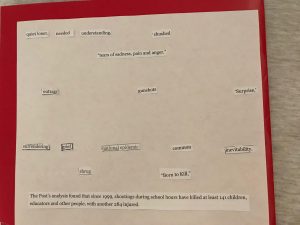Throughout the lyric Citizen, the speaker brings up many examples of racism that she has faced throughout her life, and how she is trying to cope with these situations. In the final section of Citizen, a quote that stood out was, “Yes, and this is how you are a citizen: Come on. Let it go. Move on.” (Rankine 151). This quote stood out because it relates to the speaker’s message throughout. The fact that she is a woman of color defines who she is in society to many others. She often questions this throughout the book, yet she is still treated as less than her white peers. This is tiring, and she begins to stop caring about this treatment. When she hears a racist remark instead of instantly trying to question the reality of the statement, she says that, “what happens to you doesn’t belong to you, only half concerns you” (Rankine 141). This shows some of the speaker’s defeat. She recognizes here that who she is as a citizen cannot be changed easily. She still cares about this mistreatment, but begins to realize that this is just who she is as a citizen and loses motivation to seek change.
A coping mechanism that the speaker uses to deal with this reality is humor. The speaker is able to laugh with her friends over many situations where she is treated unfairly. For example, when she pays for dinner the waitress gives the debit card back to her white friend. Instead of reacting poorly, “you laugh and ask what else her privilege gets her? Oh, my perfect life, she answers. Then you both are laughing so hard, everyone in the restaurant smiles” (Rankine 148). This shows how she laughs off white privilege and the microaggressions that she faces in society. It is ironic that the rest of the restaurant smiles at the girls, because they are likely guilty of similar behaviors as the waitress.
Laughter also has a negative impact on the speaker. When she does choose to act out against racist behaviors, she is seen as a joke. She feels upset because when she chooses to call out a microaggression, “everyone you ask is laughing that kind of close-the-gap laughter: all the ha-ha’s wanting uninterrupted views. Don’t be ridiculous. None of the other black friends feel the same way and how you feel is how you feel even if what you perceive isn’t tied to what is…” (Rankine 152). Those laughing at her will accept no views but their own, and laugh in her face when they have no idea how the statement may have impacted her. They compare her reaction to those f all of her friends, regardless of the fact that everyone has different experiences.
This is another theme throughout. African Americans are grouped together as being the same in every aspect, even how they look. The speaker struggles with this, as she feels as though she is overreacting to a situation simply because her friends were not upset. This is another example of a microaggression towards the speaker, as all individuals have different experiences that will draw different reactions to the comment. This laughter shows how people believe that blacks have a certain role as a citizen. For the group that was laughing at her, she was a target for their jokes, and was expected not to react to them in a negative way, but to simply laugh along. She feels conflicted as of how to react, since others were not bothered. When trying to ensure that this was not an overreaction on her part, she says that “It’s not that (is it not that?) you are oversensitive or misunderstanding” (Rankine 152). This shows how she is confident that her reaction is normal, but due to her widely accepted “role” as a citizen, even she begins to question herself.
- What other coping mechanisms have you noticed the speaker using to deal with racism in society?
- What are some other examples of white privilege in the lyric?

